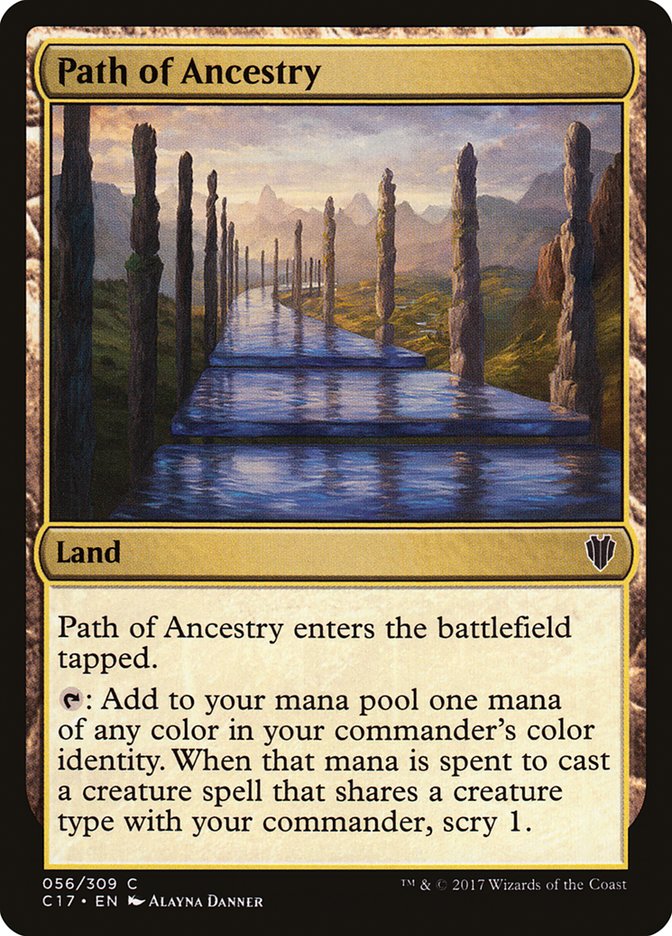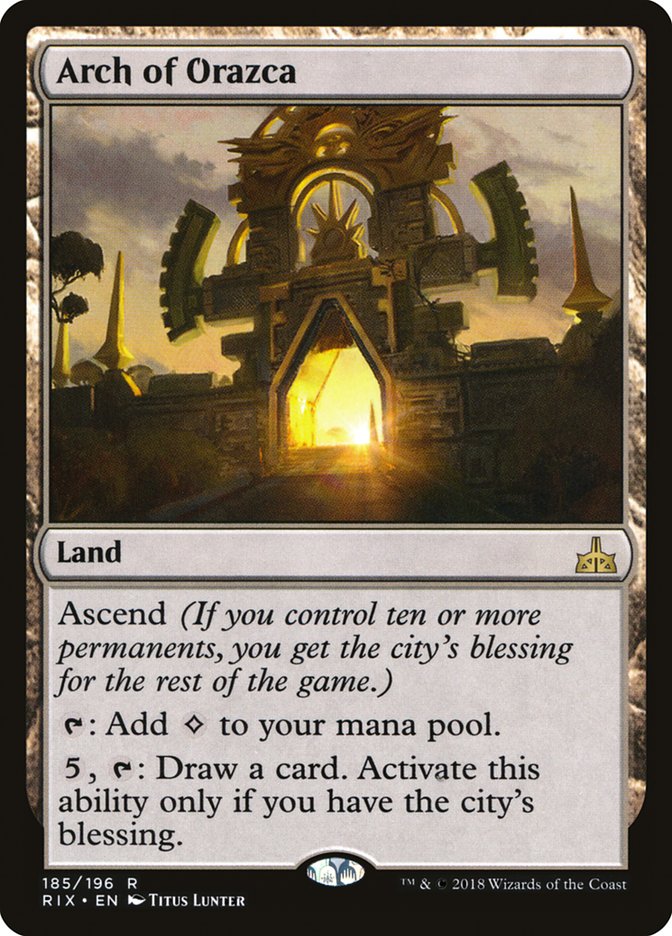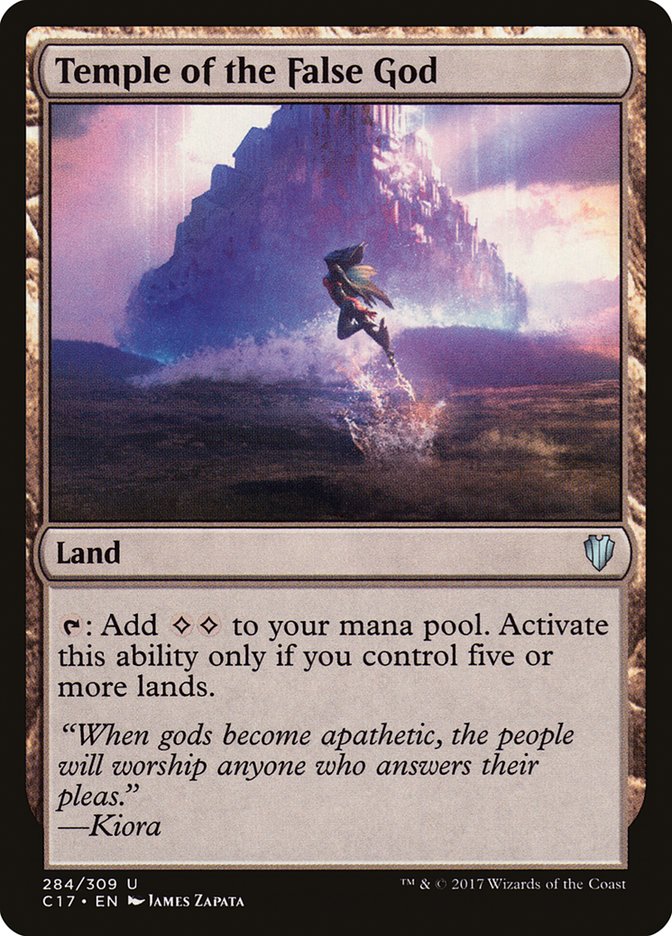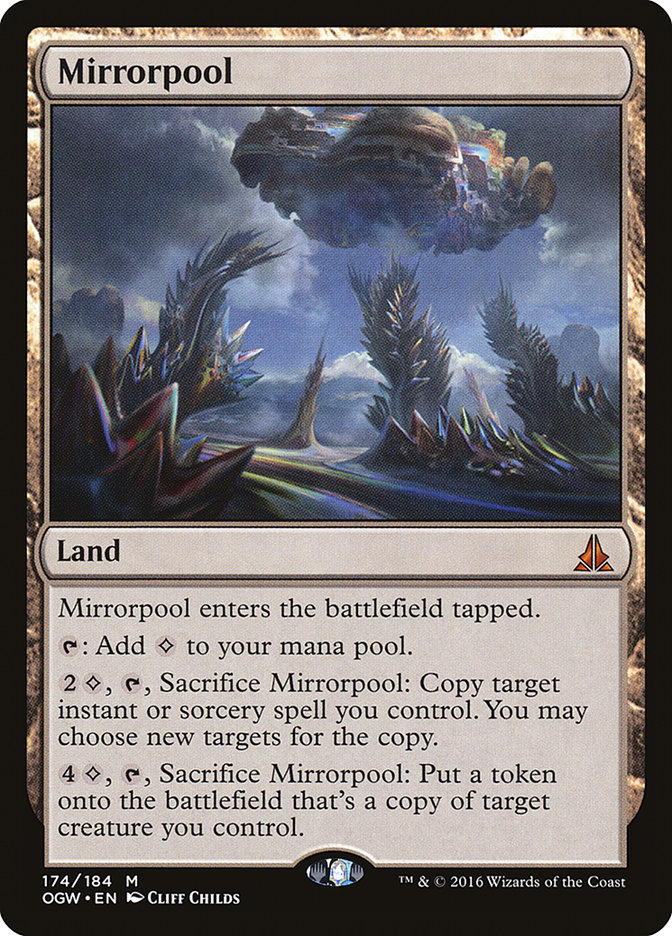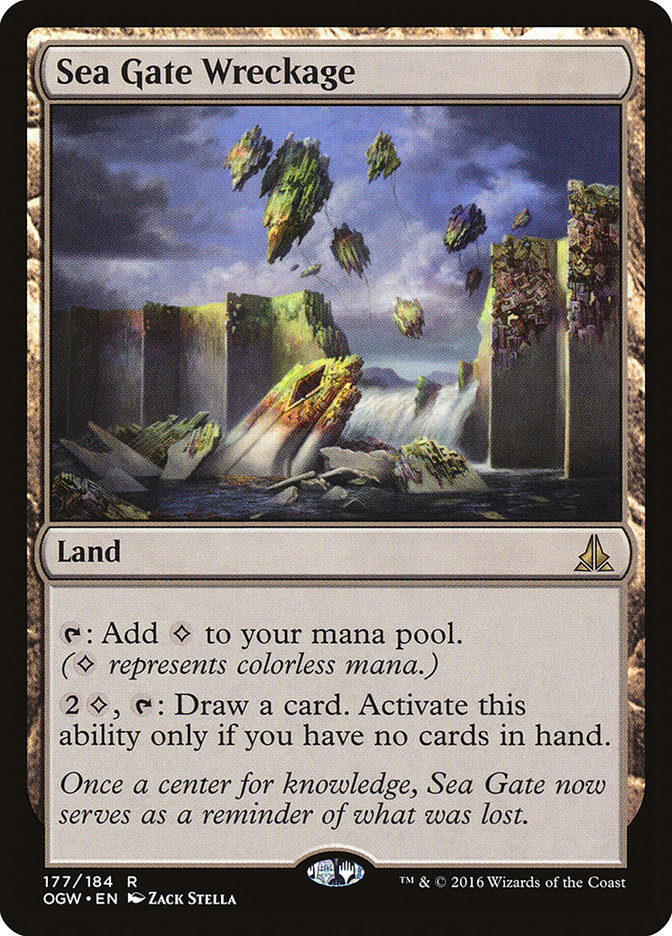This week I thought I’d pause from talking about specific Commander decks
and instead discuss some fundamentals of deckbuilding. Specifically, lands.
For instance, you probably need to play this more:
It was kind of sneaky putting this card in a Commander product that was so
focused on tribal synergies. It’s easy to glance at this card, nod, and
toss it into any of your tribal decks. We all love tribal decks. Attaching
a scry trigger to each of our tribal cards is good times. Smiles all
around!
But hang on a second. This isn’t like Cavern of Souls where you have to
name a particular creature type to gain benefit from the card. This taps
for any color mana that’s part of your commander’s color identity, and you
can use that mana to cast whatever spells you want, not just tribal spells.
So, the very worst-case scenario, the floor on this card, is a Command
Tower that enters the battlefield tapped, and whenever you use it to cast
your commander, you get to scry.
Is the floor of this card worth playing in a mono-color or two-color deck?
Unlikely. We’d probably want a substantial number of cards that share a
creature type with our commander cards before we add Path of Ancestry. But
consider these cards:

If you’re playing a three-, four-, or five-color deck, you’re probably
playing with these cards because having a land that taps for one of three
colors is awesome when your color identity gets complicated. I would
suggest if you’re playing with any of these cards in your deck, you should
also play Path of Ancestry because it’s strictly better than these cards at
the floor and the more colors are in your deck and the more creatures in
your deck share your commander’s creature type, the better this gets.
Path of Ancestry. It’s not just for tribal decks!
Also, this card probably belongs in any deck that’s not playing four or
five colors:
I’ve been scooping up copies of Arch of Orazca because they’re currently
cheap as dirt, and I anticipate playing this card in Commander decks
forever. Unless you’re playing with the spikiest of Commander Spikes,
getting to ten permanents is trivially easy. Once you’ve got that city’s
blessing, Arch will do you good work when you’re running low on gas. This
is essentially a colorless Whispers of the Muse that can tap for mana. It’s
especially good when you’ve got instant speed answer cards that you want to
keep ready if needed but don’t want to waste all your mana each turn.
Conversely, all y’all need to stop playing this card:
That’s right-I broke out the plural form of y’all (I’m Southern, I get to
do that) to make sure that all of y’all stop playing this terrible card.
Look, I know everyone gets caught up in living the dream of having access
to six mana on turn 5. Or maybe even turn 4 if you’re playing a ramp spell
like Cultivate or Sakura-Tribe Elder. But wouldn’t it be nice if your sweet
land tapped for mana before you had five lands on the battlefield? We’re
playing a 100-card singleton deck; occasionally you’re going to miss a land
drop in the first four or five turns of the game. Let’s be honest, if
you’ve got five lands on the battlefield early in the game you’re already
doing pretty good, you’ve got mana to cast some spells and participate.
That makes Temple of the False God a “win more” card. There are going to be
times when you keep a three-land hand that looks pretty good but then draw
expensive spell after expensive spell and all you want is to draw your
fourth land so you can cast Solemn Simulacrum… and you’re going to draw
Temple of the False God instead.
Which does nothing for you as your fourth
land other than sit there on the battlefield smirking at you, not doing any
work and taking up a slot in your deck that could go towards a basic land
that’s happy to tap for mana immediately. This is the wiz kid with the
awesome resume’ you hire who ends up doing nothing but drinking all your
coffee and surfing the internet all day. Hire the solid worker who gets
things done instead.
Temple of the False God is an aptly named trap, and it makes me mad when
Wizards prints it in their Commander products. I have been known to rip up
the card into little pieces despite the cool artwork. I wouldn’t
necessarily advocate doing that, but I would strongly recommend sticking
them in the back of your land box and ignoring its siren song. There are
numerous great land cards you can play in your Commander decks, and Temple
of the False God is not even remotely one of them.
You also probably shouldn’t play these:

I know this borders on heresy, and I fully acknowledge there are exceptions
to this rule (which I will bring up in a moment), but I think may too many
people play fetchlands when they shouldn’t. I understand the
appeal-sacrifice and you can search up a variety of lands that provide you
with two colors. The original duals, shocklands, Battle lands, the cycling
lands from Amonket, what have you.
Here’s the thing. Each of the fetchlands is a tutor. You’re not cracking a
fetchland to search up a basic land unless it’s way in the late game and it
doesn’t matter. So, you’re going to be searching for a very specific land,
and that takes time to find, and then you’ve got to shuffle your giant deck
afterwards. And since you’re probably fetching up a land to cast a spell
with, everyone is sitting there waiting for you to do your thing. For
Commander it’s usually best if you don’t have too many tutors in your deck
to delay the game, and then sprinkling in more of them in land form just
adds to the down time.
Here’s another, subtler thing: shuffling your deck is a resource. Just
think about one of the most powerful interactions ever printed in
competitive Magic: Brainstorm and a fetchland. Draw three cards, pick the
two least useful cards, put them back on top of your deck and crack the
fetchland to shuffle them away. Now that Jace, the Mind Sculptor is
unbanned we’re going to see that powerful interaction in Modern.
In Commander there are a fair number of cards where it’s a nice resource to
be able to shuffle your library on demand. For instance, in addition to
Brainstorm and Jace, the Mind Sculptor:

Here’s the thing: what if your opening hand has Sylvan Library, a Forest,
and some sweet three mana cards. If your last card is a Misty Rainforest
and you don’t draw another land in the first two draws, you’ll have to use
Misty Rainforest to get your second land and waste the shuffle.
Instead, play more of these:

If that second land in your hand was Bant Panorama, you can tap it for
colorless mana and play Sylvan Library. Now you can hang onto Bant
Panorama, using it for mana, and pop it off when you need to reset the top
of your library.
Of course, there are exceptions to this rule. If your Commander table is
very competitive and games go fast, by all means use the fetchlands
instead. They are incredibly efficient and you probably aren’t worried
about resetting the top of your library all that much. There are also
Commander decks where having lands enter the battlefield or graveyard, such
as landfall cards, Knight of the Reliquary, or The Gitrog Monster, in which
case the fetchlands make a lot of sense. Of course, in those cases you
could play some Panoramas too!
Panoramas also provide colorless mana, and sometimes that’s important. For
instance, these are really good lands to have in your deck if you’ve got a
fair number of colorless mana sources:
Not to mention all the sweet Eldrazi that require colorless mana to cast or
activate abilities for.

I know some of these might be in your Modern deck, but give them a whirl in
Commander!
So, what about these?

When Oath of the Gatewatch came out and Wizards of the Coast
unveiled the sixth color of Magic, “colorless,” I thought it was a
brilliant move. Suddenly, the painlands went from being tier two color
fixers to being tri-lands, which was awesome. I hope that Wizards will
circle back around to cards that care about colorless mana sooner rather
than later. If your deck is playing a fair number of Eldrazi and special
lands that require colorless mana, then I can see playing these in
Commander; if not, I’m generally not a big fan of these in the format. If
one of these cards is the only source of colored mana from the beginning of
the game, you can end up taking a lot of damage.
One last thing: you’re probably not playing enough lands in your Commander
deck. Yeah, I know, when you add in all the artifact mana, creatures that
tap for mana, and ramp spells, your deck might be pushing 50% mana
production. So it’s tempting to scrimp on your actual land count to squeeze
in more cool cards. But think about 60 card decks: in Standard, the
standard for lands is 24 in a 60-card deck. If your deck is very aggressive
with a low mana curve, you may shave a few lands. If your deck is slower
and more mana hungry, you may add a few. That’s 40% lands. 40% of 100 cards
in Commander is 40 lands. I usually go by a baseline of 38 lands, but I’ll
very rarely go less than that and will often go higher if my Commander is
more expensive. Here’s the thing: If you stall on land drops in a duel,
you’ve only got one opponent that’s pulling ahead of you. In Commander,
you’ve got multiple opponents pulling ahead of you. You want to avoid
missing land drops in the early game if at all possible, and playing plenty
of lands can help with that. You can mitigate land shortage with a free
mulligan, but after that you pay the very real cost of losing a starting
card-again, you’re falling behind not just one opponent but multiple
opponents.
Of course, on the flip side is the very real possibility of land flood,
which is slightly less frustrating but something that can quickly drain the
fun out of a game of Commander. Make sure you put in plenty of cards you
can sink excess mana into for effect. Hey, you can even add some lands that
are good mana sinks:

Also, the numerous creature-lands make good mana sinks too.
So, what do you think? Agree with some of what I’ve laid out here?
Disagree? Let me know your thoughts on lands in Commander!
For more Commander goodness, be sure to check out Sheldon Menery’s
excellent strategy article
The Philosophy of Second Best
. Commander is a format where you want to play big, splashy haymaker cards,
but sometimes being the first to do so can gain too much attention from
your opponents. Sheldon gives some tips for showing a little bit of
restraint and let someone else take the heat until the time is ripe. On the
video front, the
Commander Vs team play four more random decks built by the West
brothers
. Justin rocks Pang Tong, “Young Phoenix”, Stephen Green goes old school
with Halfdane, Jeremy gets devoted to Ephara, God of the Polis, and
Jonathan Suarez is heaving stuff with Brion Stoutarm.
New to Commander?
If you’re just curious about the format, building your first deck, or trying to take your Commander deck up a notch, here are some handy links:
-
Commander Primer Part 1
(Why play Commander? Rules Overview, Picking your Commander) -
Commander Primer Part 2
(Mana Requirements, Randomness, Card Advantage) -
Commander Primer Part 3
(Power vs. Synergy, Griefing, Staples, Building a Doran Deck) -
Commander Starter Kits 1
(kick start your allied two-color decks for $25) -
Commander Starter Kits 2
(kick start your enemy two-color decks for $25) -
Commander Starter Kits 3
(kick start your shard three-color decks for $25)
Commander write-ups I’ve done
(and links to decklists):
• Zurgo Bellstriker (Bellstriking Like a Boss)
• Dragonlord Ojutai (Troll Shroud)
• Karrthus, Tyrant of Jund (Dragons, Megamorphs, and Dragons)
• Dromoka, the Eternal (One Flying Bolster Basket)
• Shu Yun, the Silent Tempest (Tempests and Teapots)
• Tasigur, the Golden Fang (Hatching Evil Sultai Plots)
• Scion of the Ur-Dragon (Dragon Triggers for Everyone)
• Nahiri, The Lithomancer (Lithomancing for Fun and Profit)
• Titania, Protector of Argoth (Titania’s Land and Elemental Exchange)
• Reaper King (All About VILLAINOUS WEALTH)
• Feldon of the Third Path (She Will Come Back to Me)
• Sidisi, Brood Tyrant (Calling Up Ghouls with Sidisi)
• Zurgo Helmsmasher (Two Times the Smashing)
• Anafenza, the Foremost (Anafenza and Your Restless Dead)
• Narset, Enlightened Master (The New Voltron Overlord)
• Surrak Dragonclaw (The Art of Punching Bears)
• Avacyn, Guardian Angel; Ob Nixilis, Unshackled; Sliver Hivelord (Commander Catchup, Part 3)
• Keranos, God of Storms; Marchesa, the Black Rose; Muzzio, Visionary Architect (Commander Catchup, Part 2)
• Athreos, God of Passage; Kruphix, God of Horizons; Iroas, God of Victory (Commander Catchup, Journey into Nyx Edition)
• Kurkesh, Onakke Ancient (Ghost in the Machines)
• Jalira, Master Polymorphist (JaliraPOW!)
• Mishra, Artificer Prodigy (Possibility Storm Shenanigans)
• Yisan, the Wanderer Bard (All-in Yisan)
• Selvala, Explorer Returned (Everyone Draws Lots!)
• Grenzo, Dungeon Warden (Cleaning Out the Cellar)
• Karona, False God (God Pack)
• Doran, the Siege Tower (All My Faves in One Deck!)
• Karador, Ghost Chieftain (my Magic Online deck)
• Karador, Ghost Chieftain (Shadowborn Apostles & Demons)
• King Macar, the Gold-Cursed (GREED!)
• Niv-Mizzet, the Firemind ( Chuck’s somewhat vicious deck)
• Roon of the Hidden Realm (Mean Roon)
• Skeleton Ship (Fun with -1/-1 counters)
• Vorel of the Hull Clade (Never Trust the Simic)
• Anax and Cymede (Heroic Co-Commanders)
• Aurelia, the Warleader ( plus Hellkite Tyrant shenanigans)
• Borborygmos Enraged (69 land deck)
• Bruna, Light of Alabaster (Aura-centric Voltron)
• Damia, Sage of Stone ( Ice Cauldron shenanigans)
• Derevi, Empyrial Tactician (Tribal Birds)
• Emmara Tandris (No Damage Tokens)
• Gahiji, Honored One (Enchantment Ga-hijinks)
• Geist of Saint Traft (Voltron-ish)
• Ghave, Guru of Spores ( Melira Combo)
• Glissa Sunseeker (death to artifacts!)
• Glissa, the Traitor ( undying artifacts!)
• Grimgrin, Corpse-Born (Necrotic Ooze Combo)
• Jarad, Golgari Lich Lord (drain you big time)
• Jeleva, Nephalia’s Scourge ( Suspension of Disbelief)
• Johan (Cat Breath of the Infinite)
• Jor Kadeen, the Prevailer (replacing Brion Stoutarm in Mo’ Myrs)
• Karona, False God (Vows of the False God)
• Konda, Lord of Eiganjo ( The Indestructibles)
• Lord of Tresserhorn (ZOMBIES!)
• Marath, Will of the Wild ( Wild About +1/+1 Counters)
• Melira, Sylvok Outcast ( combo killa)
• Mirko Vosk, Mind Drinker ( Outside My Comfort Zone with Milling
)
• Nefarox, Overlord of Grixis (evil and Spike-ish)
• Nicol Bolas (Kicking it Old School)
• Niv-Mizzet, Dracogenius ( new player-friendly)
• Nylea, God of the Hunt ( Devoted to Green)
• Oloro, Ageless Ascetic (Life Gain)
• Oona, Queen of the Fae (by reader request)
• Phage the Untouchable ( actually casting Phage from Command Zone!)
• Polukranos, World Eater (Monstrous!)
• Progenitus (
Fist of Suns and Bringers
)
• Reaper King (Taking Advantage of the new Legend Rules)
• Riku of Two Reflections (
steal all permanents with Deadeye Navigator + Zealous Conscripts
)
• Roon of the Hidden Realm ( Strolling Through Value Town)
• Ruhan of the Fomori (lots of equipment and infinite attack steps)
• Savra, Queen of the Golgari ( Demons)
• Shattergang Brothers (Breaking Boards)
• Sigarda, Host of Herons ( Equipment-centric Voltron)
• Skullbriar, the Walking Grave ( how big can it get?)
• Sliver Overlord (Featuring the new M14 Slivers!)
• Thelon of Havenwood ( Campfire Spores)
• Trostani, Selesnya’s Voice ( new player-friendly)
• Uril, the Miststalker (my “more competitive” deck)
• Varolz, the Scar-Striped (scavenging goodness)
• Vorosh, the Hunter ( proliferaTION)


